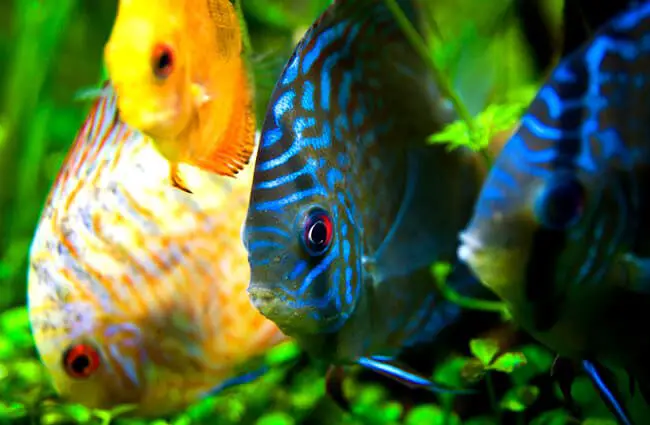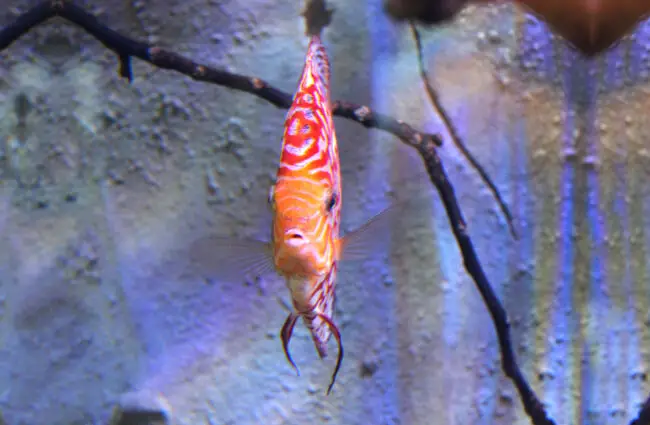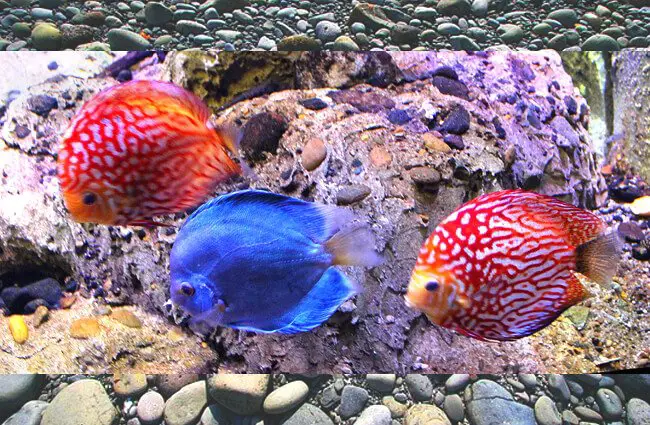Deep within the labyrinthine waterways of the Amazon, a creature of unparalleled beauty glides with serene majesty. Often hailed as the “King of the Aquarium,” the Discus fish is more than just a pretty face; it is a marvel of evolution, a testament to the intricate balance of its ecosystem, and a fascinating subject for anyone captivated by the natural world. From its distinctive disc-like shape to its complex parental care, the Discus offers a window into the wonders of freshwater life.
The Majestic Discus: A Jewel of the Amazon
The Discus, belonging to the genus Symphysodon, is a group of freshwater cichlids native to the Amazon River basin. Renowned for their vibrant colors, intricate patterns, and flattened, disc-shaped bodies, these fish are instantly recognizable. Their elegance and often calm demeanor have made them highly sought after in the aquarium trade, but their story begins far from glass tanks, in the wild, flowing waters of South America.

Where the Wild Discus Roam: Habitat and Distribution
The natural habitat of the Discus is exclusively within the vast Amazon River system and its tributaries across Brazil, Peru, and Colombia. These fish are typically found in slow-moving, calm waters, often in areas known as “igapós” (flooded forests) and “igarapés” (small creeks). They prefer the shelter of submerged roots, fallen branches, and dense aquatic vegetation, which provide both cover from predators and a rich foraging ground.
Discus species are particularly associated with blackwater rivers, such as the Rio Negro, where the water is stained dark by tannins and humic acids released from decaying vegetation. This unique environment is characterized by:
- Low pH: Often acidic, ranging from 4.5 to 6.5.
- Soft Water: Very low mineral content.
- Stable Temperatures: Typically warm, between 26°C and 30°C (79°F to 86°F).
- Low Light: Dense canopy cover and stained water reduce light penetration.
While blackwater is their most famous haunt, some species or populations can also be found in clearwater or even whitewater tributaries, adapting to slightly different parameters. An animal lover hoping to find Discus in the wild would need to embark on an expedition deep into the Amazon, focusing on these specific types of calm, vegetated areas, perhaps with the guidance of local experts who know their precise hiding spots.

A Glimpse into the Past: Discus Evolution and Taxonomy
Discus fish are members of the Cichlidae family, a diverse group of freshwater fish known for their complex behaviors and rapid speciation. Their evolutionary journey has sculpted them into highly specialized inhabitants of the Amazon’s unique aquatic environments.
The genus Symphysodon currently recognizes several species, though their classification has been a subject of ongoing scientific debate and revision:
- Symphysodon discus (Heckel Discus): Often considered the “true” Discus, known for its distinctive vertical bar through the eye and a central dark bar.
- Symphysodon aequifasciatus (Green Discus): Characterized by green coloration and often found in clearwater.
- Symphysodon haraldi (Blue/Brown Discus): Widely distributed and variable in color.
- Symphysodon tarzoo (Red Discus): Recently recognized, often with red coloration.
Their disc-like shape is an adaptation for navigating dense vegetation and submerged roots, allowing them to maneuver with agility. The intricate patterns and colorations serve as camouflage among the dappled light and shadows of their habitat, helping them blend into the background of decaying leaves and wood.

What’s on the Menu? The Discus Diet
In their natural environment, Discus are primarily omnivores, with a diet that reflects the bounty of the Amazonian waters. Their feeding habits are adapted to their slow-moving, vegetated habitats.
Their wild diet typically includes:
- Insect Larvae: Especially mosquito larvae and other aquatic insect forms.
- Small Crustaceans: Such as copepods and cladocerans.
- Detritus: Decomposing organic matter, which can be a significant food source.
- Algae and Plant Matter: Grazing on biofilm and soft plant material.
- Small Worms: Found in the substrate.
Discus are opportunistic feeders, gently picking at surfaces and sifting through substrate with their small, protrusible mouths. Their diet is crucial for their vibrant coloration and overall health, highlighting the importance of a varied and nutritious food source for captive specimens.

The Dance of Life: Mating and Reproduction
The reproductive strategy of the Discus is one of the most fascinating aspects of their biology, showcasing an extraordinary level of parental care rarely seen in fish. Discus form strong, monogamous pair bonds, often for life.
- Pair Formation: In a group, pairs will naturally form, often displaying territorial behavior and “shaking” or “shimmying” to attract a mate.
- Spawning Site Preparation: The bonded pair will meticulously clean a vertical surface, such as a broad leaf, a piece of submerged wood, or a rock. This cleaning involves nipping and rubbing the surface.
- Egg Laying and Fertilization: The female will then lay rows of adhesive eggs on the cleaned surface, followed immediately by the male, who fertilizes them. This process can last for several hours, resulting in hundreds of eggs.
- Parental Guarding: Both parents diligently guard the eggs, fanning them with their fins to ensure oxygenation and removing any unfertilized or fungused eggs.
- Hatching and Fry Care: After a few days, the eggs hatch into wrigglers, which remain attached to the spawning site. Once they become free-swimming, the true marvel begins.
- Mucus Feeding: The fry feed exclusively on a specialized, nutrient-rich mucus secreted from the skin of both parents. This unique behavior is critical for the fry’s survival and growth during their first few weeks. The parents’ skin darkens during this period, signaling to the fry where to feed.
This dedicated parental care ensures a higher survival rate for the young in the challenging Amazonian environment, making the Discus a prime example of advanced reproductive strategies among fish.

Discus in the Grand Tapestry of Life: Ecosystem and Interactions
Within the complex food webs of the Amazon, Discus play a role as both consumer and consumed. Their presence contributes to the overall biodiversity and health of their specific microhabitats.
- Prey Item: Young Discus, in particular, can fall prey to larger predatory fish, such as piranhas, larger cichlids, and catfish. Birds and even some reptiles may also prey on Discus in shallow waters.
- Consumer: By feeding on insect larvae, small crustaceans, and detritus, Discus help regulate invertebrate populations and contribute to nutrient cycling within their ecosystem. They are part of the intricate balance that keeps the Amazonian waterways thriving.
- Interaction with Other Animals: Discus typically coexist peacefully with other non-aggressive fish species in their habitat, often sharing the same sheltered areas. Their calm demeanor means they are not usually aggressive towards other fish, focusing instead on their own foraging and reproductive activities.
Discus and Humanity: A Complex Relationship
The Discus has forged a unique connection with humans, primarily through its captivating beauty.
- Discus in Human Culture: The Discus is a highly prized ornamental fish globally. Its striking appearance has led to extensive selective breeding, resulting in countless color morphs and patterns not found in the wild. It symbolizes elegance and sophistication in the aquarium hobby, often being the centerpiece of elaborate display tanks. For many aquarists, successfully keeping and breeding Discus is considered the pinnacle of freshwater fish keeping.
- Interaction with Humans:
- Aquarium Trade: The primary interaction is through the collection of wild specimens for the aquarium trade, though captive breeding now supplies the vast majority of fish. This trade has both economic benefits for local communities and potential conservation concerns if not managed sustainably.
- Ecotourism: As interest in the Amazon grows, ecotourism offers opportunities for people to observe Discus in their natural habitat, fostering appreciation and supporting conservation efforts.
- Conservation: Habitat destruction, pollution, and unsustainable fishing practices pose threats to wild Discus populations. Conservation initiatives are crucial to protect these magnificent fish and their unique Amazonian homes.
Encountering Discus in the Wild: A Guide for Explorers
For the intrepid animal lover or aspiring zoologist, finding Discus in their natural habitat is a truly special experience. However, it requires patience, respect for the environment, and often local guidance.
- Where to Find Them:
- Focus on the Amazon Basin, particularly the blackwater rivers like the Rio Negro, and its numerous tributaries.
- Look for areas with slow-moving water, dense submerged vegetation, fallen trees, and root systems.
- Shallow, sheltered coves and flooded forest areas (igapós) are prime locations.
- How to Spot Them:
- Discus are masters of camouflage. Their disc shape and vertical bars allow them to blend seamlessly with the vertical lines of submerged roots and branches.
- Observe quietly from a distance. Look for subtle movements among the vegetation.
- They often move in small groups, gently picking at surfaces.
- Visibility can be low in blackwater, so patience and keen observation are key.
- What to Do (and Not Do) if You Encounter One:
- DO: Observe from a respectful distance. Take photographs without flash if possible. Appreciate their natural beauty in their undisturbed environment.
- DO NOT: Attempt to catch or touch them. Do not disturb their habitat by moving logs or plants. Avoid making sudden movements or loud noises that could stress them. Remember, you are a guest in their home.
The Art of Discus Care: Insights for Zookeepers and Enthusiasts
Caring for Discus in captivity, whether in a home aquarium or a professional zoological setting, requires dedication and a deep understanding of their specific needs. Their sensitivity to water quality and environmental stability makes them a challenging but rewarding species to keep.
Habitat Replication and Water Parameters
The cornerstone of successful Discus keeping is replicating their natural Amazonian environment as closely as possible.
- Water Temperature: Maintain a stable temperature between 28°C and 30°C (82°F to 86°F). Fluctuations can cause stress.
- pH: Aim for soft, acidic water, ideally between 6.0 and 6.8. While captive-bred Discus can tolerate slightly higher pH, stability is paramount.
- Water Hardness (GH/KH): Keep hardness very low, typically below 5 dGH.
- Filtration: Robust biological and mechanical filtration is essential to maintain pristine water quality. Sponge filters, canister filters, or sumps are common.
- Tank Size: A minimum of 75 gallons (280 liters) for a group of 5-6 adult Discus is recommended, with larger tanks always preferred.
- Decor: Provide plenty of hiding spots with smooth driftwood, broad-leaf plants (like Amazon swords), and smooth river rocks. Avoid sharp objects.
Diet in Captivity
A varied and high-quality diet is crucial for health and vibrant coloration.
- High-Quality Prepared Foods: Specialized Discus flakes and pellets should form the base.
- Frozen Foods: Bloodworms, brine shrimp, mysis shrimp, and daphnia are excellent supplements.
- Homemade Mixes: Many zookeepers and advanced hobbyists prepare their own beef heart or turkey heart mixes, often fortified with vitamins and spirulina.
- Feeding Frequency: Young Discus require multiple small feedings throughout the day (4-6 times), while adults can be fed 2-3 times daily.
Social Structure and Tank Mates
Discus are schooling fish and thrive in groups of at least 5-6 individuals. Keeping them in smaller numbers can lead to stress and aggression among individuals. Choose tank mates carefully:
- Suitable Tank Mates: Non-aggressive, peaceful fish that prefer similar water parameters, such as cardinal tetras, rummy-nose tetras, peaceful plecos (e.g., bristlenose), and some dwarf cichlids.
- Unsuitable Tank Mates: Aggressive fish, fin-nippers, very fast-moving fish that outcompete Discus for food, or fish that require significantly different water conditions.
Breeding in Captivity
Breeding Discus is a specialized endeavor, often done in dedicated breeding tanks with even more stringent water quality control. The unique mucus feeding behavior means that parents must be in peak health to nourish their fry.
Common Challenges and Prevention
Discus are sensitive fish, and vigilance is key to preventing issues.
- Stress: Often caused by poor water quality, unstable parameters, aggressive tank mates, or insufficient hiding places.
- Disease: Prone to bacterial infections, parasitic infestations (especially internal flagellates like Hexamita), and fungal issues if water quality is poor.
- Water Quality: The most common cause of problems. Regular, large water changes are non-negotiable.
Tasks for a Zookeeper Caring for Discus
- Daily:
- Feed multiple small meals.
- Observe fish for any signs of stress, disease, or unusual behavior.
- Check water temperature.
- Several Times a Week:
- Perform large water changes (50% or more, depending on bioload and filtration).
- Test water parameters (pH, ammonia, nitrite, nitrate).
- Weekly/Bi-weekly:
- Clean tank glass and substrate.
- Rinse filter media (in old tank water to preserve beneficial bacteria).
- Monthly/Quarterly:
- Deep clean filters.
- Inspect equipment (heaters, pumps).
- Quarantine new fish rigorously.
Tasks to Avoid
- Overfeeding: Leads to poor water quality and digestive issues.
- Sudden Water Parameter Changes: Drastic shifts in temperature, pH, or hardness are highly stressful.
- Overcrowding: Causes stress, aggression, and rapid deterioration of water quality.
- Aggressive Tank Mates: Will stress and potentially injure Discus.
- Using Harsh Chemicals: Avoid strong cleaning agents near the tank or medications not specifically formulated for sensitive fish.
- Neglecting Water Changes: This is the most critical mistake.
Fascinating Facts About Discus
Beyond their care requirements, Discus hold many intriguing secrets:
- “King of the Aquarium”: This moniker is well-earned due to their majestic appearance and demanding care.
- Parental Mucus: The unique behavior of parents secreting a nutrient-rich mucus for their fry to feed on is almost unparalleled in the fish world.
- Color Variations: Wild Discus exhibit natural variations, but selective breeding has produced an astonishing array of captive strains with colors like pigeon blood, cobalt blue, red turquoise, and more.
- Disc Shape: Their flattened, round body shape is a perfect adaptation for navigating dense, root-filled environments.
- Longevity: With proper care, Discus can live for 10 years or even longer in captivity.
- Sensitivity: They are often considered an “indicator species” in aquariums; if your Discus are thriving, your water quality is likely excellent.
- Vertical Bars: Discus can rapidly display or hide their vertical stress bars, a visual cue to their mood or health.
The Discus fish is a true gem of the Amazon, embodying both delicate beauty and remarkable resilience. Whether observed in the wild, studied by an aspiring zoologist, or meticulously cared for by a dedicated zookeeper, these magnificent cichlids continue to inspire awe and curiosity. Their existence reminds us of the incredible biodiversity of our planet and the importance of protecting the precious ecosystems they call home.

![Red Angus Closeup of a beautiful Red Angus cowPhoto by: U.S. Department of Agriculture [pubic domain]https://creativecommons.org/licenses/by/2.0/](https://animals.net/wp-content/uploads/2020/03/Red-Angus-4-238x178.jpg)




![Red Angus Closeup of a beautiful Red Angus cowPhoto by: U.S. Department of Agriculture [pubic domain]https://creativecommons.org/licenses/by/2.0/](https://animals.net/wp-content/uploads/2020/03/Red-Angus-4-100x75.jpg)

